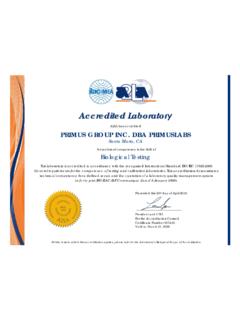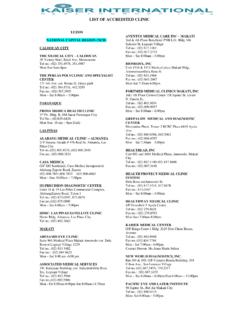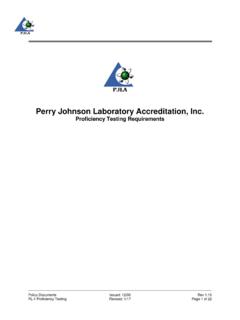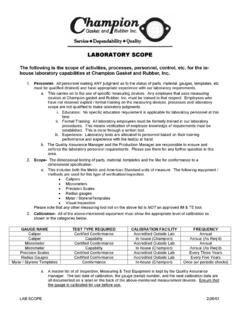Transcription of The feed analysis laboratory: Establishment and …
1 ISSN 1810-0708. 15. FAO ANIMAL PRODUCTION AND HEALTH. guidelines THE feed analysis laboratory : Establishment AND. QUALITY CONTROL. Setting up a feed analysis laboratory , and implementing a quality assurance system compliant with ISO/IEC 17025:2005. Cover photographs: Left and centre: de Jonge Right: FAO/Jon Spaull 15. FAO ANIMAL PRODUCTION AND HEALTH. guidelines THE feed analysis laboratory : Establishment AND. QUALITY CONTROL. Setting up a feed analysis laboratory , and implementing a quality assurance system compliant with ISO/IEC 17025:2005. Authors de Jonge Animal Nutrition Group Wageningen University The Netherlands Jackson Manager, Nutrition laboratory Massey University New Zealand Editor Harinder Makkar FOOD AND AGRICULTURE ORGANIZATION OF THE UNITED NATIONS. Rome, 2013. Recommended Citation de Jonge, & Jackson, 2013. The feed analysis laboratory : Establishment and quality control. Setting up a feed analysis laboratory , and implementing a quality assurance system compliant with ISO/IEC 17025:2005.
2 Makkar, ed. Animal Production and Health Guidelines No. 15. Rome, FAO. The designations employed and the presentation of material in this information product do not imply the expression of any opinion whatsoever on the part of the Food and Agriculture Organization of the United Nations (FAO) concerning the legal or development status of any country, territory, city or area or of its authorities, or concerning the delimitation of its frontiers or boundaries. The mention of specific companies or products of manufacturers, whether or not these have been patented, does not imply that these have been endorsed or recommended by FAO in preference to others of a similar nature that are not mentioned. The views expressed in this information product are those of the author(s) and do not necessarily reflect the views or policies of FAO. ISBN 978-92-5-108071-9 (print). E-ISBN 978-92-5-108072-6 (PDF). FAO, 2013. FAO encourages the use, reproduction and dissemination of material in this information product.
3 Except where otherwise indicated, material may be copied, downloaded and printed for private study, research and teaching purposes, or for use in non-commercial products or services, provided that appropriate acknowledgement of FAO as the source and copyright holder is given and that FAO's endorsement of users' views, products or services is not implied in any way. All requests for translation and adaptation rights, and for resale and other commercial use rights should be made via or addressed to FAO information products are available on the FAO website ( ) and can be purchased through iii Contents Contents iii Foreword vii Abbreviations viii Acknowledgements ix Chapter 1. Introduction 1. Background 1. Aim 1. A road map of the document 2. Chapter 2 Development of a business plan 3. Introduction 3. Approach for development of a business plan 3. Type of laboratory to be developed 3. Market analysis for potential customers and their needs 4. Types of analyses 6. Market analysis for available laboratory services 6.
4 Evaluation and decision making 7. Chapter 3 Setting up and running the laboratory 11. Introduction 11. Physical realization of the laboratory 11. The analytical process 12. Methods to be made operational 13. Building and facilities 18. Equipment 24. Organizational structure and responsibilities of personnel 26. Realization of the laboratory Procedures 27. Continuity and improvement of the laboratory 28. iv Chapter 4 Implementation of a Quality Management System and the road to accreditation 31. Introduction 31. Basic principles of quality 31. Technical level 32. Organization level 37. Commercial level 40. Reading and interpretation of ISO/IEC 17025:2005. 41. A road map for building a high quality system 50. First situation: Routine stand-alone feed analysis laboratory 50. Introduction 50. Initial phase 51. First year 52. Second year 52. Third year 54. Fourth year 56. Second situation: Routine laboratory connected to a feed manufacturer 58. Third situation: laboratory as part of a research organization 59.
5 Fourth situation: Government or reference laboratories 60. Sources used 63. Appendix A. Ensuring quality analytical performance 65. Appendix B. First line of quality control and the use of Shewhart charts 73. Appendix C. Validation requirements 77. Appendix D. Calculation of uncertainty of measurement 79. Appendix E. An example of technical records for a determination 81. v Appendix F. An example of a maintenance and calibration document 83. Appendix G. An example of a training record 85. Appendix H. Procedure for traceability of volumetric calibration 87. Appendix I. Trend analysis 89. vii Foreword feed has a fundamental influence on productivity, health and welfare of the animal. feed quality influences animal product quality and safety, and the environment. To achieve bal- ance among these parameters, the animal's nutritional requirements must be properly met. Confidence in the nutritional information on any feed or feed ingredient provided by suppliers is critical for buyers because it provides a guarantee of feed quality.
6 Current reports from many countries suggest that manufacturers and buyers do not always have confidence in the data provided from non-accredited laboratories, which can negatively affect market prices and international trade. It is therefore important that laboratories work towards adopting a Quality Assurance System for all of their routine feed analyses. This has been detailed in two FAO Animal Production and Health Manuals: No. 14, Quality Assurance for Animal feed analysis Laboratories, and No. 16, Quality Assurance for Microbiology in feed analysis Laboratories. Not only must the methods used be of an internationally recognized standard, but all steps in the process, from the initial sample submission through to the final report preparation, must be traceable. An internationally accredited laboratory gives producers and buyers of feed a great deal of confidence in the data they receive. This provides wider market possibilities for feed manufacturers. Also, the right nutritional information about feed ingredients and feeds will enable preparation of balanced diets that meet the nutritional requirements to match the physiological stage of animals and to satisfy the farmer's husbandry objectives.
7 This document presents a step-by-step process to guide the laboratory management team through the various stages, from planning the feed analysis laboratory building and layout, to hiring suitable staff and choosing which methods to set up, with appropriate equipment requirements. A detailed guideline for initiating a Quality Management System starts with validation of methods, personnel and training; addresses systematic equipment maintenance, calibration, proficiency testing and quality control procedures; and final reporting and auditing, all culminating in a final accreditation inspection within an estimated four-year time frame. The authors have extensive laboratory experience as well as personal experience with successfully bringing non-accredited laboratories up to an internationally recognized accredi- tation standard. The content of the document has been peer reviewed by a large number of experts and their suggestions incorporated. The guidelines presented will assist governments and feed manufacturers, as well as a range of institutions, including research and education, to work towards Establishment of a feed analysis laboratory whether as an integral unit or as an independent commercial laboratory with internationally recognized accreditation.
8 Berhe G. Tekola Director Animal Production and Health Division viii Abbreviations Absorption Unit AAS Atomic Absorption Spectroscopy ANOVA analysis of variance CRM Certified Reference Material CUSUM Cumulative sum FAO Food and Agriculture Organization of the United Nations FAO/IAEA FAO/IAEA Agriculture and Biotechnology laboratory GC Gas chromatography GC-FID Gas Chromatography-Flame Ionization Detector GC-MS Gas Chromatography-Mass Spectrometry HPLC High Performance Liquid Chromatography IAEA International Atomic Energy Agency ICP Inductively Coupled Plasma [ analysis ]. ICP-AES Inductively Coupled Plasma Atomic Emission Spectroscopy ILAC International laboratory Accreditation Cooperation ISO International Organization for Standardization LC-MS Liquid Chromatograph Mass Spectrometer LIMS laboratory Information Management System LOD Limit of Detection LOQ Limit of Quantification MS Mass Spectrometer MS-MS Sequential mass spectrometry MU Measurement of uncertainty NIR Near-Infrared Spectrometry PR Public Relations PSG Project Steering Group QA Quality Assurance QMS Quality Management System R&D Research and development ROI Return on Investment SD Standard deviation SOP Standard operating procedure UV Ultraviolet ix Acknowledgements We thank all peer reviewers, listed below, for taking time to critically read this manual and for their comments and suggestions that led to its improvement.
9 Copy editing and preparation for printing was by Thorgeir Lawrence and layout was coordinated by Claudia Ciarlantini, which are thankfully acknowledged. Jim Balthrop Quality Assurance Manager, Office of the Texas State Chemist, Box 3160, College Station, Texas 77841, United States of America Richard A. Cowie Senior Quality Assurance Manager, SRUC, Ferguson Building, Craibstone Estate, Aberdeen AB21 9YA, Scotland, United Kingdom Johan DeBoever Senior Researcher feed Evaluation, Institute for Agricultural and Fisheries Research, Animal Sciences Unit, Scheldeweg 68, 9090. Melle, Belgium E. Fallou Gu ye Animal Production Expert, Animal Production and Health Division, FAO, Viale delle Terme di Caracalla, 00153 Rome, Italy Gustavo Jaurena Professor, Animal Nutrition, Centre of Research and Services in Animal Nutrition, Facultad de Agronom a, Univ. de Buenos Aires, Av. San Mart n 4453 - C1417 DSQ, Ciudad Aut noma de Buenos Aires, Argentina Alicia N jera Molina International Quality Assurance Manager, Masterlab bv, The Netherlands E.
10 Odongo Animal Nutritionist, Animal Production and Health Section, Joint FAO/IAEA Division, IAEA, Vienna, Austria, Alfred Thalmann Elbinger Str. 10c, D 76139 Karlsruhe, Germany (Formerly: Staatliche Landwirtschaftliche Untersuchungs- und Forschungsanstalt Augustenberg; later Landwirtschaftliches Technologiezentrum Augustenberg). Anja T pper Head, Animal feed analysis and Microbiology Unit, Landwirtschaftliches Technologiezentrum Augustenberg, Ne lerstra e 23-31, D 76227 Karlsruhe, Germany 1. Chapter 1. Introduction Background The importance of livestock production in developing countries is increasing due to growing demands for animal products, combined with demands for more sustainable agriculture. Globalization and increased demand for animal products also offer export opportunities, leading to improved welfare for people from the exporting countries. Key elements for success, however, are high productivity and low prices, coupled with high quality and safety of animal products. Chemical analyses of diets and animal products play an essential role in achieving optimal production and guaranteeing safety for consumers.














